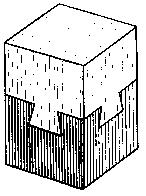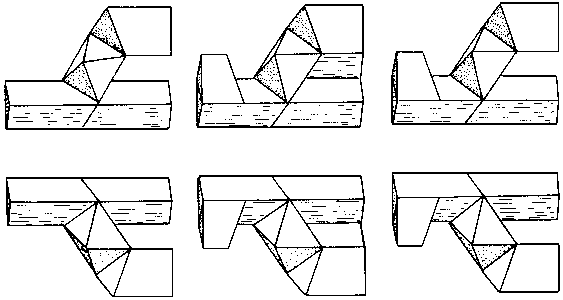 |
 |
 |
|
| Fig. 150 | |
[Home] [Contents] [Figures] [Search] [Help]
[Next Page] [Prev Page] [ Next Chapter] [Prev Chapter]
Readers are probably familiar with the novelty consisting of two blocks joined together by what looks like a pair of dovetail joints impossible to assemble or disassemble, see Fig. 150. Deceptions of this sort sometimes appear in polyhedral puzzles. One does not expect the Star of David Puzzle to come apart along a diagonal sliding axis. This principle is exploited in the design shown, which has a perfectly prismatic assembled shape but in which the first step of disassembly is a separation into two halves along an unexpected diagonal axis. The construction of these puzzle pieces is similar to that used for the intersecting prism puzzles in Chapter 10, with triangular stick segments attached to six-sided center blocks. The six dissimilar pieces of the version shown are in reflexive pairs. The two end faces are finished true after assembly.
Note that none of the designs described in this book, even in this diabolical chapter, employs concealed locking devices such as hooks, catches, tumblers, or the like. Patent files reveal that one of the preoccupations of puzzle inventors over the years has been to devise such mechanisms, the object being to defeat them and open some secret box or toy bank. Does this fascination with locks and concealment tell us something about ourselves? The number of security devices that one must necessarily deal with in daily life is one of the most discouraging aspects of our civilization. Yet how casually we take them for granted, even turning them into recreations and children's toys!
| ©1990-2005 by Stewart T. Coffin For questions or comments regarding this site, contact the chief metagrobologist: |
[Next Page] [Prev Page] [ Next Chapter] [Prev Chapter]